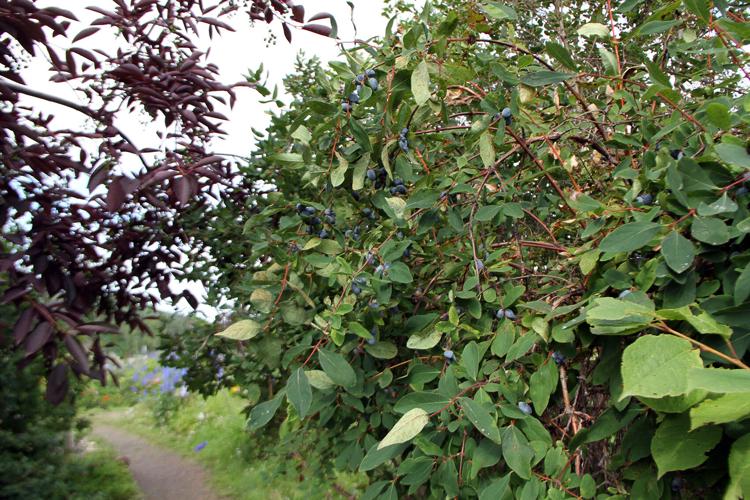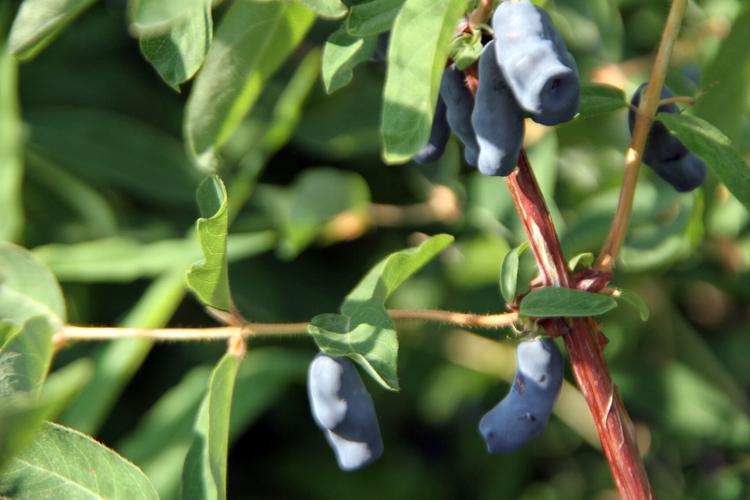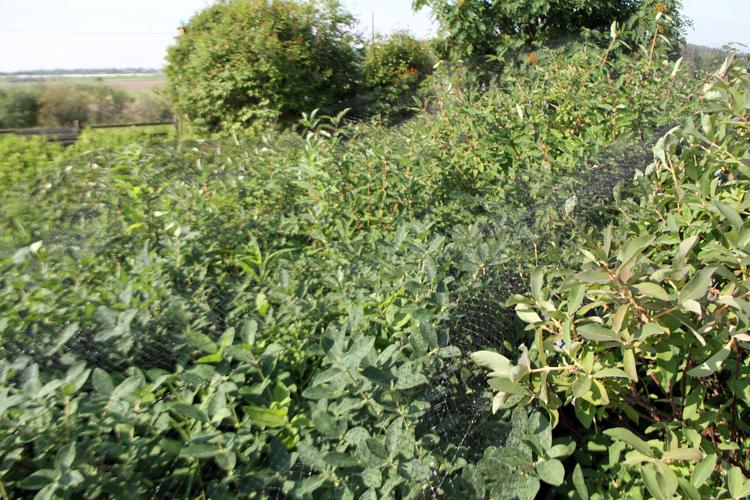Honeyberries, or haskaps, are a unique berry. Honeyberries have a huge range in shape, size, productivity, taste, timing and evenness in how they ripen, as well as in how easily they come off the bush. The taste of honeyberries is often compared to other berries. I think the taste is unique, and you should try them and make your own comparisons (or not) with other berries.
I have written several articles on berries and they are roughly in order of my personal preference: first, on cultivating wild blueberries, next strawberries, then raspberries and then currants. So now I’m tackling honeyberries or haskaps, so they are my fifth favorite berry. They would be sixth if you include cloudberries, but I’m not going to write about cloudberries since they are generally not cultivated, although there may be ways to protect and promote their growth in the wild.
Some berries require full sun, a narrow pH range and well-drained soils. Honeyberries tolerate partial shade, wet soils and a wide pH range. Their pruning requirements are more manageable than other types of berries, and they won’t take over your backyard with thorny bushes like raspberries tend to do. What’s not to like about a berry that is easy to grow, cold, hardy, highly productive and ripens earlier than most berries?
Lonicera caerulea (honeyberry, haskap, blue honeysuckle) was originally cultivated in Japan and Russia. Later, researchers at Oregon State University and the University of Saskatchewan bred many new varieties.
Over the years, about 20 varieties of honeyberries have been planted at the University of Alaska Fairbanks Georgeson Botanical Garden. There is now quite a patch that has started to grow together. Of these varieties, Borealis and Blue Belle are the only ones still widely available. Borealis was touted as the best-tasting variety in the University of Saskatchewan Fruit Program in 2007, but Boreal Blizzard may have surpassed it.
In 2021, the Boreal series (Boreal Beauty, Boreal Blizzard, and Honey Bee (pollinator for Borealis, Tundra, and Indigo series), which were developed at the University of Saskatchewan in 2017, were planted at the Georgeson. Boreal Beauty matures about a month later than other honeyberries, and Boreal Blizzard has large, very tasty berries. According to garden manager Lacey Higham, the plants all seem to be thriving. The Alaska Berry Farm has bred a number of haskap varieties that also thrive in Alaska. Utah State University Extension recommends Tundra, Borealis, Indigo Gem, Blue Lightning and Kamchatka.
The Fairbanks Soil and Water Conservation District will have haskaps and other berries, trees and shrubs for sale from 10 a.m. to 4 p.m. on May 23-24 in the Delta Barn at the Tanana Valley State Fairgrounds. Their compost sale will be at the same time and place.
Along with choosing varieties for taste or other characteristics, you need to choose at least two varieties that will pollinate each other. For haskaps to set fruit, each variety must be pollinated by a variety that is compatible and blooms at the same time. Along with choosing varieties for taste or other characteristics, you need to choose at least two varieties that will pollinate each other. For haskaps to set fruit, each variety must be pollinated by a variety that is compatible and blooms at the same time. This chart delineates which varieties are compatible for cross pollination. Dr. Bob Bors, haskap researcher and breeder extraordinaire at the University of Saskatchewan, has detailed information online about the ideal layout for haskaps as well as which varieties pollinate which. A so-called pollinator plant is usually not as tasty as the primary variety you are growing. There are many varieties to choose from—One Green World has 28 honeyberry varieties. Descriptions include timing of maturity and which varieties are compatible pollinators.
You can plant as few pollinators as a 1:24 ratio. However, if the pollinator variety is as desirable as the other variety, you can simply plant them in alternating rows. To maintain individual plants, plant 4 to 4.5 feet apart with rows 8 to 10 feet apart. For a hedge, plant 3 feet apart. Haskaps tolerate a wider range of soil acidity or pH than many other types of berries — up to nearly 8. Also, unlike many berries, they thrive in wetter soils. Ideally, the pH would be between 5-7 and somewhat well-drained soil. Soil should be fertilized before planting and each spring. Newly established plants need to be regularly watered, but established plants can be watered less. Weeding is also important for establishment.
After plants are about 3 years old, dead or damaged branches should be pruned, as well as up to about 25% of the older branches. This will help maintain adequate air flow and productivity of the plants.
Birds will eat the honeyberries before they’re even ripe so you’ll need netting with a mesh smaller than half an inch to cover the berries. You can float the netting over the berries or put it over poles so you can harvest the berries easily with the netting on. Some varieties hide their berries from the birds a little better than others. Powdery mildew may be an issue as well.
Honeyberry flowers are just about the first flowers to emerge in the spring and are frost and cold hardy. Bumblebees or honeybees may pollinate these early flowers. Honeyberries may appear to be ripe before they are truly ripe will still be a little green inside and won’t taste as good as ripe berries. You’ll want to wait five to 10 days from when they are first blue on the outside to be fully ripe on the inside.
Before you harvest en masse, taste a few — don’t we always do this anyway? Depending on the variety of berry, there is a range of when, how quickly and how evenly they ripen. Some varieties hold on to their berries better, while some tend to drop them sooner. According to the University of Saskatchewan, mature haskap plants can produce 5 to 10 pounds of fruit each year (or more!).
I am still getting acquainted with the honeyberry, but I saw a delicious-looking recipe for Haskap Meringue Pie in the Edible Vancouver Magazine. I would also suggest trying them in muffins, scones, pies or jams.
Heidi Rader is a professor of Extension and project director for the Alaska Tribes Extension Project. This work is supported by the Federally Recognized Tribes Extension Program Project 2022-41580-37957. It is a partnership with Tanana Chiefs Conference. Any opinions, findings, conclusions, or recommendations expressed in this publication are those of the author(s) and do not necessarily reflect the view of the U.S. Department of Agriculture.
















